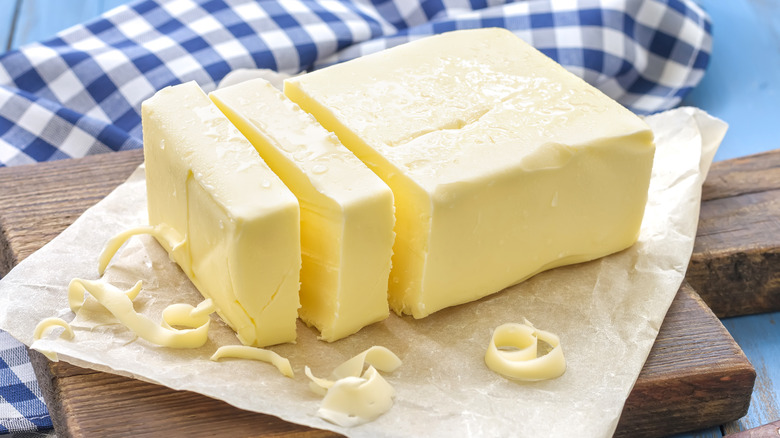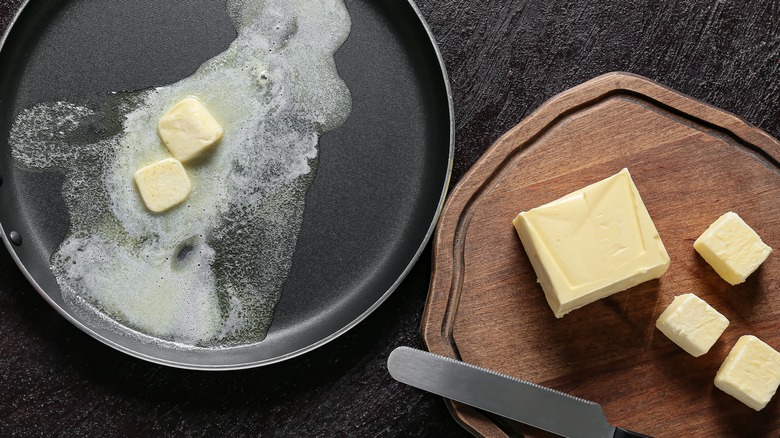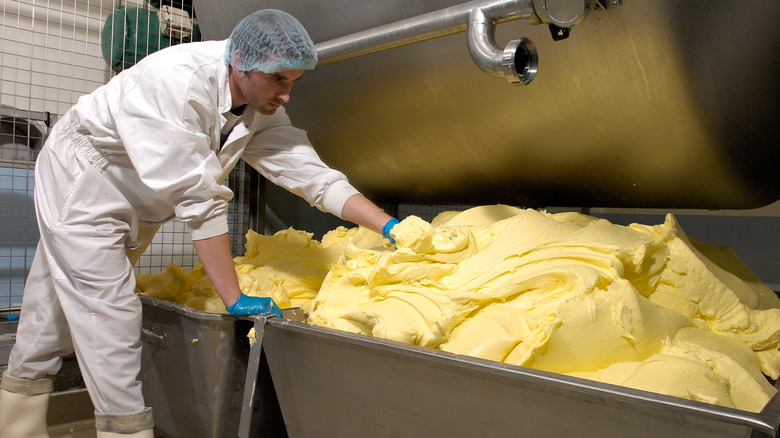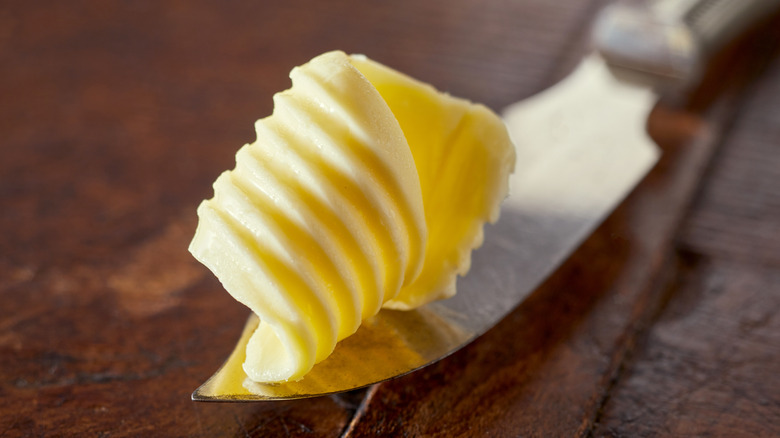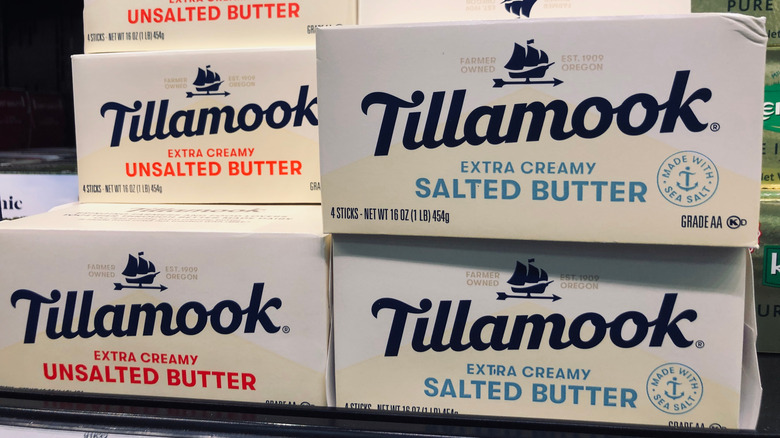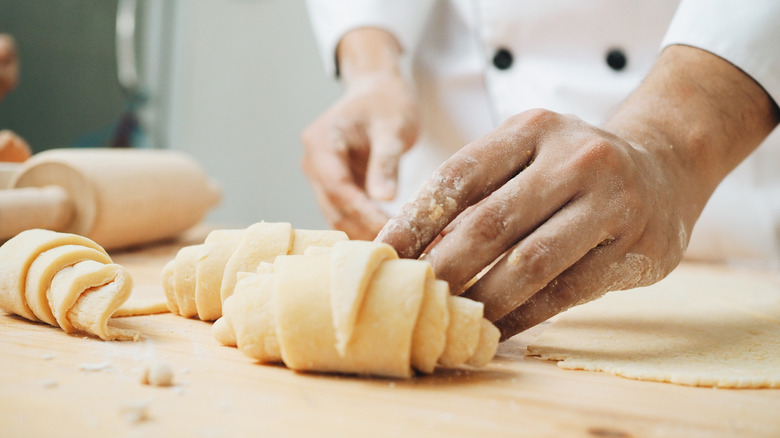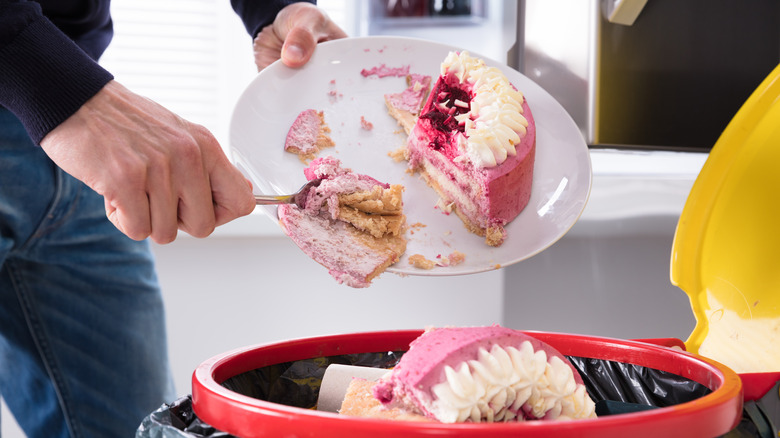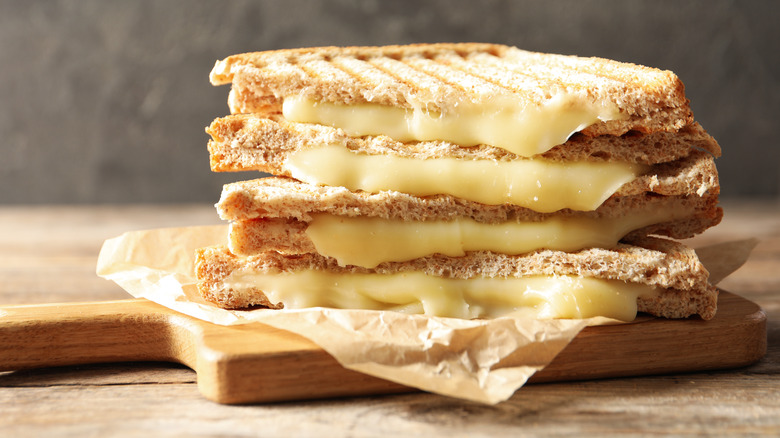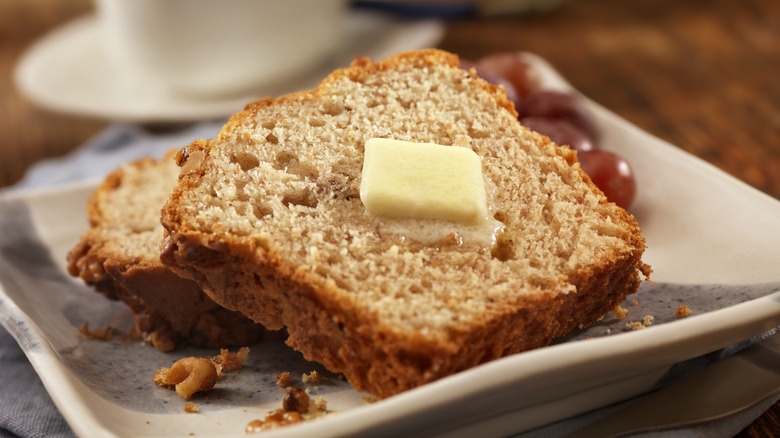10 Facts You Need To Know About European Butter
Butter is magical. It turns simple recipes into succulent sensations very quickly. Whether you're using it in a savory dish, folding it into baked goods, or just spreading it on toast — butter is a delightful go-to ingredient. It awakens the taste buds and ignites a flavorful fireworks display we all love. Around the world, people use butter every day. To say that this luscious ingredient is a staple in the culinary space is an understatement.
However, there are many types of butter to choose from, some of which you may not be aware of. When it comes to butter options, there's one in particular that embodies indulgence — European butter. European butter has garnered the attention of influential chefs and home cooks alike. It's known for its rich flavor, soft texture, and brightly colored yellow appearance. When incorporating it into cooking, it can add decadence to a dish, but it can also hinder it. This is why it's critical to understand the characteristics of European butter. Depending on what you're making, it can make or break your meal.
Luckily, we've put together some important facts you should know before purchasing and utilizing this creamy, golden spread. From its origins to how it's produced to the ideal culinary applications — we've got you covered.
European-style butter is not necessarily from Europe
If you're looking to buy European butter in the grocery store, it's best to be watchful. Although European butter is often sourced directly from Europe, this isn't always the case. Butter advertised in American markets as "European-style" is sometimes made in the United States. For example, Plugrá is cultivated using European techniques, but it's really produced in Kansas City, Missouri. "European-style" typically just refers to butter made with a slightly higher fat content compared to American-style butter, but its production can happen anywhere.
When seeking out genuine, European-sourced butter, it's important to look directly at the packaging. On the backside of the packaging, usually towards the bottom, there should be text that says "Product of [Country]." For example, Kerrygold is a European-style butter sold in most U.S. markets. On the backside of their packaging, you can see that it says, "Product of Ireland." Indeed, their Irish butter is of authentic origin. Made with milk from grass-fed cows and known for its creamy texture, Kerrygold butter is a great choice.
It has a higher percentage of butterfat
European-style butter, whether it's made in Europe or not, typically ranges from 82% to 90% butterfat. This is higher than American-style butter, which sits at an average of 80%. Although it may seem like a rather insignificant difference, don't be fooled by the small percentage change. The slightly higher fat content can greatly enhance the flavors and textures of your dish.
When caramelizing ingredients like onions, even a 2% increase in butterfat boosts caramelization. This makes European-style butter one of the best butter types for browning. The butter is softer, melts faster, and heats up more rapidly than regular butter. These characteristics allow the ingredients to quickly develop the quintessential brown hue and bedrock depth of flavor we all love. Additionally, the increased butterfat content in European-style butter makes it an excellent choice for butter-based sauces like béchamel, béarnaise, or a simple lemon-garlic combination. Fat adds flavor, and European-style butter brings this refined yet mouthwatering element to the table.
It goes through a fermentation process
As opposed to most American-style butter, European-style butter goes through a fermentation process, also known as culturing. The process holds the key to unlocking its signature texture and flavor. Often, people will not only comment on the lusciousness of the butter but the pleasant tang that accompanies it.
Culturing begins by letting the cream sit in the presence of beneficial bacteria — grown to sour milk products — before it's churned. Sometimes though, the cultures are added in reverse after the butter is churned. This method tends to create butter that is less tart and milder than the first method. Either way, the fermentation process gives European-style butter the unique and complex flavor profile it's known for. Try using cultured, European-style butter in a cauliflower au gratin recipe. The rich, slightly nutty, and tangy notes of European butter complement the decadent, cheesy flavors of this dish.
It's churned more slowly
When it comes to European-style butter, cultured butter is churned more slowly. Although typically an old-fashioned butter-making technique, the slow churning method makes the butter richer and more velvety. It also builds aromatic notes which delight the palate. In Europe, in particular, there are even more standards in place to ensure that the butter meets a certain level of quality — another difference between American-made and European-made butter.
This is particularly noticeable when it comes to artisan butter makers in Europe. They follow stricter regulations from start to finish of the butter-making process. For example, close monitoring of the cows' diets, milk production, and cream fermentation process takes place across many countries and cities. This ensures consumers are purchasing high-quality products that are made using time-honored manufacturing methods. The resulting butters are generally raw, uncultured, and preservative-free — which means they're not as widely available since the cream can spoil more quickly. Still, artisan butter makers like the French Jean-Yves Bordier sell their spectacular butter around the world.
If you've never tried artisanal European butter, we recommend splurging for a special occasion. These butter makers devote many hours to their craft and handmade products. The result is beautifully shaped, textured, and flavored butter.
It's more luxurious and expensive on average
Today, European-style butter is more expensive than American-style butter. As of June 2023, a pound of regular butter in the U.S. costs about $4.45 on average. European brands like Irish Kerrygold and French Président can go for around $10 per pound. There are obviously different price points and factors to be considered, like whether or not the butter was actually produced in Europe, but the manufacturing process and higher percentage of butterfat in European-style butter will cost you more regardless.
The premium prices of European-style butter are not for everyone. We recommend you save this type of butter for special occasions or for finishing touches. In terms of sheer price, it makes more sense to buy regular butter for everyday cooking, especially when butter-flavor or buttery texture is not overtly needed. Many chefs prefer using European butter in their homes as opposed to restaurants for this very reason. The silky quality and luxurious taste often outweigh the cost when the butter is meant for only a few people. Culinary legend Nancy Silverton's favorite butter is a French one made by Rodolphe Le Meunier. Silverton once told Treehouse Hotels that if she were stranded on a desert island, her food of choice would be bread and Rodolphe Le Meunier's salted beurre de baratte.
Like most butters, you can choose from salted or unsalted
Depending on what you're using the butter for, European-style butter comes in both salted and unsalted forms. Many home cooks and chefs prefer unsalted butter for its flexibility and control over the saltiness in a dish. Most recipes also call for unsalted butter, so it's best to have this type on hand. You don't want to accidentally add salted butter to a recipe that already includes salt — you'll throw the dish's taste off and end up with an overly salty meal.
Salted butter, though, is by no means your enemy. Use it as a finisher to add allure to certain dishes. Consider it as a topper for unsalted foods like your baked potato or morning toast. We recommend going with a brand that has a wonderful depth of flavor and a higher butterfat percentage. Try Straus Family Creamery's lightly salted European-style butter. It's organic, grass-fed, and made with 85% butterfat. The butter is also made in small batches using an old-fashioned, artisanal style butter churn.
It works well with laminated pastries
Deciding between European-style and American-style butter is particularly important when baking pastries. It works well in certain dishes but can overpower others. European-style butter is best reserved for laminated pastries like croissants, danishes, cinnamon rolls, and pie crusts. Since the butter contains more fat and less water, it's easily incorporated into the dough and creates delicate yet distinct layers of lamination. This is how laminated pastries get their classic features, such as a buttery taste, flaky texture, and an overall mouthwatering bite. One aspect to be cautious of when shaping pastries is that European-style butter has a low melting point. The heat produced by your hands may cause some issues when working with the dough, but you can avoid this problem by chilling your dough beforehand.
European-style butter is also the best type of butter for pound cake recipes. This type of cake is expected to be more moist and dense — making the fattier butter a great option. It also adds a wonderful yellow hue to your pound cake that makes it more appealing to the eye, not just to taste buds. Once you use European butter for these pastries and bakes, you'll be craving the indulgent treat all day long.
It can ruin the texture of some bakes
As rich and wonderful as European butter can be, it's important to recognize that baking is very much a science. The same ingredient that can help you in one bake may hurt you in another. It turns out that extra butterfat in European-style butter may ruin the texture of your bake. The problem happens when butter is churned longer in an effort to increase butterfat. Although this does make European-style butter creamier, it also reduces the water content of your bake, causing problems with the balance of your ingredients. Sometimes the balance is so off that you'll end up having to plan a whole new dessert.
You're better off using American-style butter for certain pastries and baked goods. It has a higher melting point and holds more moisture than European-style butter. In the oven, the moisture turns slowly into steam, allowing the dough to bake evenly and rise with ease. Without this extended evaporation process, your bake may get weighed down in the oven and turn out quite dense. You'll wind up with a heavy, undesirable aesthetic and texture.
For certain dishes, it can be too much of a good thing
Yes, butter builds flavor, but in general, your dish is going to have a lot of other ingredients that give it its signature feel and taste. You don't need to go out of your way to buy European-style butter when cooking — especially if you're using it more for functionality as opposed to flavor. Additionally, sometimes too much fat can leave your dish feeling oily and unpleasant to the palate. For example, when it comes to grilled cheese, butter serves the purpose of browning and crisping the outside of your bread since the cheese and other ingredients inside the sandwich already provide the fattiness and flavor. Since butter is used mainly for its functional purpose here as opposed to flavor, you can pass on European-style butter for your next grilled cheese.
If you really want to use European-style butter, use about ¼ less than your recipe calls for. This isn't a full-proof number, but it can help keep your dish or baked goods from becoming too oily. If you're feeding a lot of people and looking to impress, consider using it where it can really shine. European-style butter is fabulous in creamy dips and rich sauces; just be sure not to overdo it.
It can be a great finish to a dish
Save the expensive, European-style butter for finishing your dishes. With its creamy flavor and low melting point, the luxurious butter works great as a topper for warm foods. Consider placing a thin square on your biscuit or muffin. If you're having a party, you can serve a savory dollop with your steaming bread rolls. You can even include it as one of the spreads on your charcuterie board. European-style butter also makes a great seasoning option for corn on the cob. Mixed it with savory flavors like chipotle, garlic, and even some cotija cheese for a take on street corn that everyone will salivate over.
The creamy, delicious flavor of European butter truly makes it the perfect finishing touch to a wonderfully cooked meal. In addition to the richness, the nuanced tang and nuttiness of European-style butter will elevate your dish from good to exquisite. When you prepare your next meal, consider using European butter where it fits best. It provides that touch of magic that will leave anyone who tries your dish wanting more!
